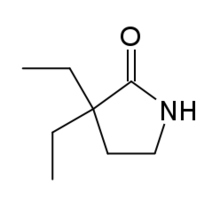3,3-Diethyl-2-pyrrolidinone
From Wikipedia, the free encyclopedia
This is an old revision of this page, as edited by Caftaric (talk | contribs) at 08:02, 4 September 2017 (in Caenorhabditis elegans). The present address (URL) is a permanent link to this revision, which may differ significantly from the current revision.
 | |
| Clinical data | |
|---|---|
| ATC code |
|
| Identifiers | |
| |
| CAS Number | |
| PubChem CID | |
| ChemSpider |
|
| ChEMBL | |
| CompTox Dashboard (EPA) | |
| ECHA InfoCard | 100.162.031 |
| Chemical and physical data | |
| Formula | C8H15NO |
| Molar mass | 141.210 g/mol g·mol−1 |
| 3D model (JSmol) | |
| |
| |
| | |
3,3-Diethyl-2-pyrrolidinone (DEABL) is an anticonvulsant drug most closely related to pyrithyldione and gabapentin.[1] It was found to extend lifespan in the nematode worms Caenorhabditis elegans.[2]
References
- ^ Hill, MW; Reddy, PA; Covey, DF; Rothman, SM (1998). "Contribution of subsaturating GABA concentrations to IPSCs in cultured hippocampal neurons". Journal of Neuroscience. 18 (14): 5103–11. PMID 9651194.
- ^ Evason, K; Huang, C; Yamben, I; Covey, DF; Kornfeld, K (2005). "Anticonvulsant medications extend worm life-span". Science. 307 (5707): 258–62. doi:10.1126/science.1105299. PMID 15653505.
| Alcohols | |
|---|---|
| Barbiturates |
|
| Benzodiazepines |
|
| Carbamates | |
| Flavonoids |
|
| Imidazoles | |
| Kava constituents | |
| Monoureides | |
| Neuroactive steroids |
|
| Nonbenzodiazepines | |
| Phenols | |
| Piperidinediones | |
| Pyrazolopyridines | |
| Quinazolinones | |
| Volatiles/gases |
|
| Others/unsorted |
|
This anticonvulsant-related article is a stub. You can help Wikipedia by expanding it. |
Hidden categories:
- Articles with changed CASNo identifier
- ECHA InfoCard ID from Wikidata
- Chem-molar-mass both hardcoded and calculated
- Infobox-drug molecular-weight unexpected-character
- Chemical pages without DrugBank identifier
- Articles without KEGG source
- Articles without UNII source
- Drugs with no legal status
- Drugboxes which contain changes to verified fields
- All stub articles
